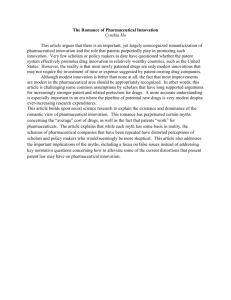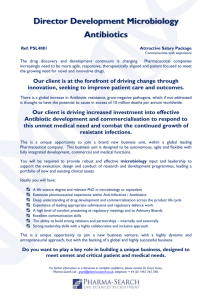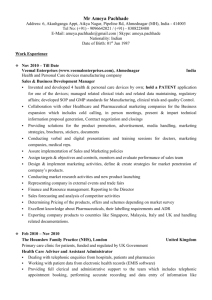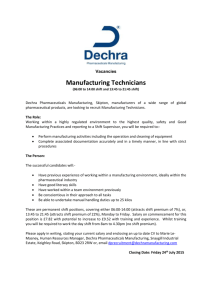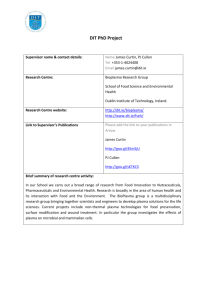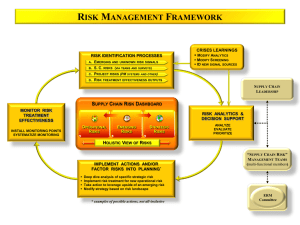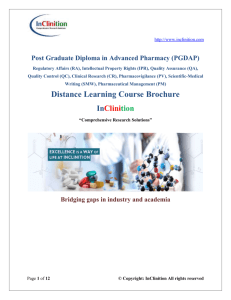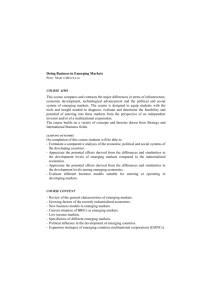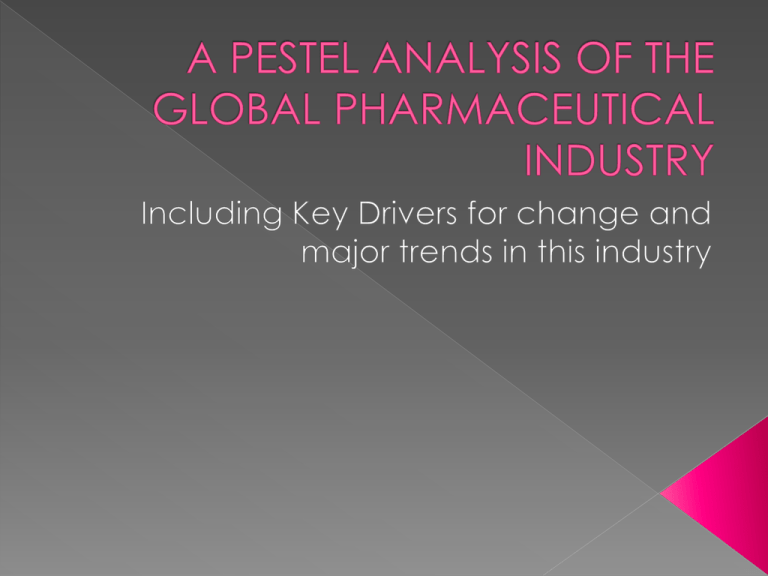
Many countries have a ‘monopsony’ where there is one
powerful purchaser; the government
Goverments have focused on pharmaceutical companies as
easy targets in their efforts to control rising health care
expenditure. Methods include price or reimbursement controls.
Government price controls also created ‘parallel trade’. Single
European Market allows distributors to pocket difference after
buying from low price market and selling in high price market.
European government has forever changing cost containment
plans
FDA perceived as too closely aligned with the industry
South African government proposed legislation to allow generic
imports of branded drugs – 39 firms took legal action – not a
good example of industry relations
Clear principles agreed on and adopted by many companies
that they would supply critical drugs to poor countries on a no
profit no loss basis
Japanese government calling for consolidation and
globalisation of domestic companies
Free trade allows wholesalers to extract a large chunk from the
value chain
New economic reality in 2006 where growth is shifting from mature
markets to emerging ones
Reduce time in which R&D costs could be recouped
Universal coverage systems, i.e NHS in UK too slow or unable to
introduce latest treatments and insurance funded systems i.e In USA
some people can afford treatments, but not all. 15.9% of US population
without health insurance
Methods imposed to control pharmaceutical spending
Venture capitalists offering funding for new industry players like
biotechnology companies
Pharmaceutical growth is aligned with GDP growth
Companies costs for providing drug benefits to employees were
increasing by up to 20% annually.
MCO’s asked consumers for increasing co-pays on branded versus
generic drugs
Economic recession in Japan
Slowing European economies
Chinese government pouring money into new universities and science
parks
Acquisitions of biotechs
Product life cycle has shortened and R&D costs, in-licensing and
marketing costs have risen
Emerging markets accounting for 50% of global GDP growth in 2005
Regulators, payers and consumers more carefully weighing the
risk/benefit factors of pharmaceuticals
Lack of public or political support for industry
Ageing populations pressuring health care funding
Increasing patient expectations
Trend by payers to use generic drugs as first line treatment option, only
switching to patented drugs if they fail
Litigious US consumers forced MCO attention on offering optimal rather
than cheaper care leaving the door open for genuine innovation
Japan had worlds most rapidly ageing population, however in 2005 the
population itself began to decline
Emerging markets have enormous populations with high levels of unmet
need
In 2006 companies realised that well informed patients were prepared to
ask for drugs by name and were becoming increasingly vocal, well
informed, and demanding
Consumers beginning to purchase across borders with no guarantees of
drugs being safe or even genuine
Average life expectancy in developed countries increased dur8ihng 20th
century by about 20 years
Public perception of pharmaceutical companies was that they were
greedy and consumers and politicians lost trust
More educated consumers
Expensive high technology solutions
International convergence of medical science and
practice under the influence of modern communications
technology and increased travel and information
exchange
Pace of change outstripping the capabilities and powers
of regulators
New product adoption is not keeping pace with loss of
patent protection
Easy to purchase addictive painkillers and other
potentially harmful drugs over the internet and rogue
websites offering miracle cures for aids cancer
Opportunities in scientific and technological advances
Chinese government pouring money into new universities
and science parks
None identified
Regulatory controls becoming tighter
Legislation enacted to set fixed period on patent protection –
typically 20 years
Regulatory changes in 1997 lead to direct to consumer (DTC)
advertising
Regulatory processes undergoing international harmonisation
European Medicines Evaluation Agency (EMEA) established
Move towards global regulatory harmonisation through the
International Conference on Harmonisation (ICH)
Strengthened patent protection and liberalised equality controls
in emerging markets
Fake drugs account for over 10% of the global market
generating annual sales of more than $32b
Illegal drug cartels moving into the less risky, but equally as
lucrative business of fake pharmaceuticals
Between 2000 and 2003 the US Justice Department collected
over $2b in fines from cases against pharmaceuticals firms,
manly for pricing and marketing crimes
Increasingly onerous regulation
Large emerging markets with unmet
need
Market shift to specialist driven medicines
Dominant belief that size it what counts
Opportunities in scientific and
technological advances
Shorter product life cycles
Spiralling health care costs

